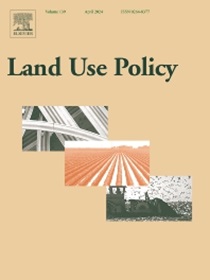人口减少阶段城郊农业的持续存在与土地所有者的行为:出租农田的优惠税收待遇案例
IF 5.9
1区 社会学
Q1 ENVIRONMENTAL STUDIES
引用次数: 0
摘要
由于世界上大多数人口居住在城市地区,尤其是广大郊区,因此对大城市郊区周围的土地使用进行控制不仅是保护农业生产力的问题,也是维持体面居住环境的问题。为解决这一问题,一项切实可行的政策措施是为出租农田的土地所有者提供优惠的税收待遇,《生产绿地法》(PGL)就是一个典型的例子,日本政府于 2018 年对该法进行了广泛修订,以保护农田,让活跃的农民在整体人口减少的情况下有效利用农田。以往的研究广泛关注于确定在城市发展阶段鼓励持久农业的因素。然而,在不断缩小的郊区,租赁农田已成为农民的实际选择,如何将农业经营的专业化、多样化、属性和选址进行适当组合。此外,多功能价值对于确保农业作为家族企业继续存在也很重要。关于保留农田并为社区提供多功能价值的郊区土地所有者属性的研究也很有限。基于对上述文献的理解,本研究探讨了与郊区农业持续存在相关的具体农场属性和地点。为此,本研究对东京都地区的郊区农户(包括小农户)进行了两波调查。主要发现如下。首先,郊区农业的持续性与农民在销售渠道和提供服务方面的多样化活动有显著关系,在农业经营方面,业务类型的专业化也是一个有利因素。同时,在地理位置方面,人口密度适中的郊区继续从事农业的概率最低。其次,从事与社区相关的多功能农业的土地所有者即使停止或缩小农业活动规模,也倾向于持有农田而不是将其转化。第三,在政策影响方面,与扩大规模的农民相比,退出和缩小规模的农民人数更多,此外,地理分布也不平衡。根据研究结果,本研究建议应鼓励通过与社区建立关系来发展多功能农业,促进新农民加入农业,并支持积极扩大农场规模的农民。本文章由计算机程序翻译,如有差异,请以英文原文为准。
Persistence of sub-urban agriculture and landowners' behavior in the population declining phase: Case of the preferential tax treatment for rental farmland
With the majority of the world’s population residing in urban areas, particularly in vast suburbs, land use control around the suburbs of large cities is a concern for not only protecting agricultural productivity but also maintaining a decent residential environment. A practical policy measure to address this concern is providing preferential tax treatments to landowners who lease out their farmland, and the Production Green Land (PGL) Act is a typical example, which was extensively revised by the Japanese government in 2018 to conserve farmlands and allow active farmers to use it effectively amid the overall population decrease. Previous studies have extensively focused on identifying factors to encourage persistent agriculture in the urban growing phase. However, the appropriate combinations of specialization, diversification, attributes, and location of farm businesses in the shrinking suburbs, where leasing farmland has become a practical option for farmers. Moreover, multifunctional value is important for ensuring that agriculture continues as a family business. Studies on the attributes of suburban landowners who keep farmland and provide multifunctional value to the community are also limited. Based on the above understanding of the literature, this study explores the specific farm attributes and locations related to the persistence of suburban agriculture. To this end, this study conducts a two-wave survey of suburban farmers, including smallholders in the Tokyo Metropolitan Area. The following key findings are observed. First, the continuity of agriculture in the suburbs is significantly related to farmers’ diversification activities in terms of sales channels and provision of services, with specialization within a business type in terms of agricultural operation also being an advantageous factor. Meanwhile, regarding the location, the probability of continuing agriculture is lowest in moderately populated suburbs. Second, landowners engaged in multifunctional agriculture that is linked with the community tend to hold farmland rather than convert it even when they stop or downscale their agricultural activities. Third, regarding the policy implication, the number of exiting and downsizing farmers was larger compared with expanding farmers, in addition to an unbalanced geographical distribution. Based on the findings, the study recommends that multifunctional agriculture through forming relationships with the community should be encouraged, new entrants to agriculture must be promoted, and active farmers who expand farm size need to be supported.
求助全文
通过发布文献求助,成功后即可免费获取论文全文。
去求助
来源期刊

Land Use Policy
ENVIRONMENTAL STUDIES-
CiteScore
13.70
自引率
8.50%
发文量
553
期刊介绍:
Land Use Policy is an international and interdisciplinary journal concerned with the social, economic, political, legal, physical and planning aspects of urban and rural land use.
Land Use Policy examines issues in geography, agriculture, forestry, irrigation, environmental conservation, housing, urban development and transport in both developed and developing countries through major refereed articles and shorter viewpoint pieces.
 求助内容:
求助内容: 应助结果提醒方式:
应助结果提醒方式:


